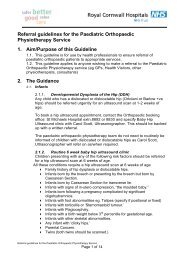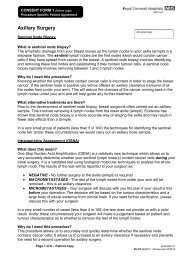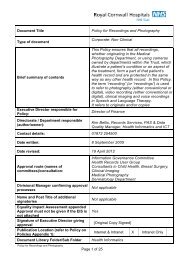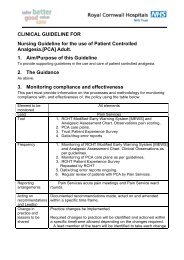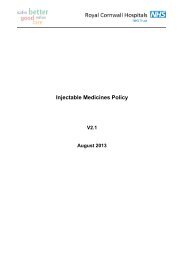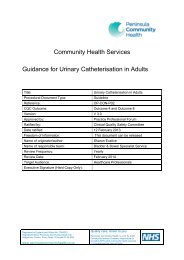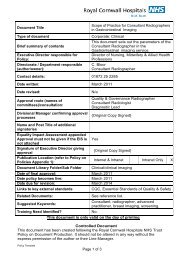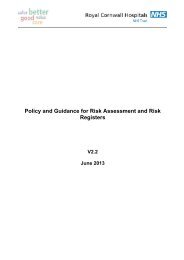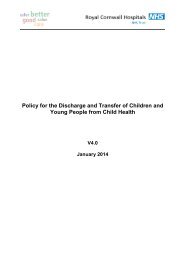(CVC) Management Guidance - the Royal Cornwall Hospitals Trust ...
(CVC) Management Guidance - the Royal Cornwall Hospitals Trust ...
(CVC) Management Guidance - the Royal Cornwall Hospitals Trust ...
Create successful ePaper yourself
Turn your PDF publications into a flip-book with our unique Google optimized e-Paper software.
11.3 Documentation of line removal must include:<br />
Reason for removal<br />
Length of ca<strong>the</strong>ter removed (which must be checked against insertion<br />
information)<br />
Confirm if <strong>the</strong> ca<strong>the</strong>ter tip has been sent for culture<br />
Technique used<br />
12 <strong>CVC</strong> Infections<br />
Infection is one of <strong>the</strong> most frequently reported complications of <strong>CVC</strong>’s. If a ca<strong>the</strong>ter related<br />
blood stream infection is suspected or confirmed, alternative vascular access should be<br />
sought until <strong>the</strong> issue is resolved.<br />
The following guidance represents current best practice however; practitioners should seek<br />
guidance from appropriate medical staff, Infection prevention & control team, microbiology<br />
team and pharmacist.<br />
Practitioners need to audit <strong>the</strong>ir own practice as part of infection prevention measures by<br />
completing a Central ca<strong>the</strong>ter form,<br />
Each time a port is accessed <strong>the</strong>re is a risk of infection. This guideline mandates ANTT<br />
when accessing a <strong>CVC</strong> which will fur<strong>the</strong>r reduce <strong>the</strong> risks of bacteraemia in lines.<br />
The method of cleaning ports and hubs prior to access is <strong>the</strong> same as all vascular access<br />
devices. A Chlorhexidine 2% and Alcohol 70% (PDI or Clinell® wipe is to be used.<br />
For patients where <strong>the</strong>re is an allergy/reaction likely to Chlorhexidine, a Povidine Iodine 10%<br />
aqueous solution should be used.<br />
12.1 Suspected Insertion Site Infections<br />
A swab must be taken from <strong>the</strong> insertion site before commencing systemic antibiotic<br />
<strong>the</strong>rapy.<br />
If a swab is taken <strong>the</strong> result must be followed up within 48 hours and discussed with<br />
<strong>the</strong> Medical <strong>Management</strong> Team.<br />
A daily assessment including VIP, Temperature, Pulse, Respirations and dressing<br />
change to be initiated.<br />
12.2 Blood Cultures<br />
Where a ca<strong>the</strong>ter related blood stream infection is suspected a minimum of two blood<br />
culture samples are required. The cultures must be taken using a closed system.<br />
One set of cultures must be taken from <strong>the</strong> <strong>CVC</strong> (or a sample from each lumen) and<br />
<strong>the</strong> o<strong>the</strong>r taken peripherally before commencing antibiotic <strong>the</strong>rapy. This is a<br />
procedure to be undertaken by medics only.<br />
13 Education<br />
13.1 Staff<br />
All registered practitioners accessing <strong>CVC</strong>’s should be fully trained in intravenous<br />
infusions, be deemed competent to PCH standards and have had additional teaching<br />
10 of 25




